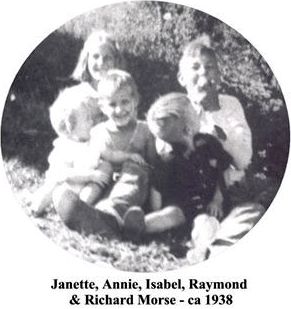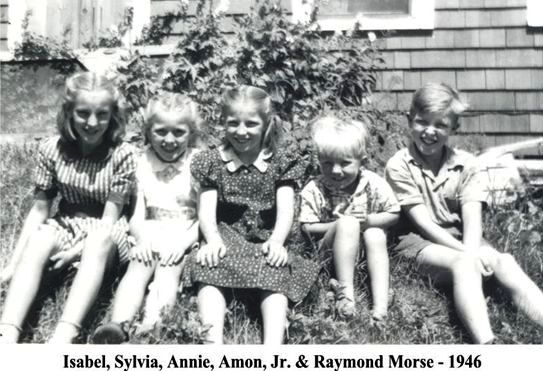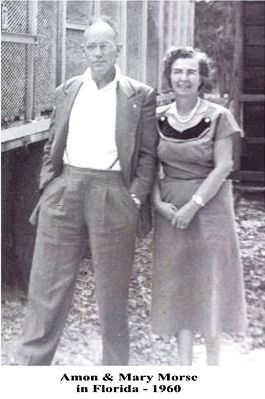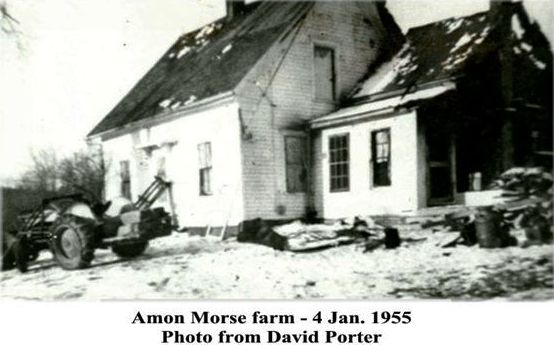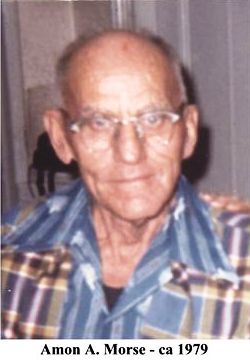“I never
was lazy, I tell ya!”, so said Amon Morse in
talking with a Republican Journal reporter
in 1989, a few months before his death. And
lazy, Amon was not. He had been born in
Belmont, Maine in 1905, the sixth child of
John W. and Jennie (Levenseller) Morse,
named after his mother’s childhood friend,
Amon, son of Dr. Frank Brown of
Lincolnville. Amon was two years old, his
brother, age one, when their mother, Jennie,
died as a result of a premature childbirth.
Amon was raised in a household of many
motherless siblings and cousins by their
loving grandmother, Susan (Shea) Morse.
There was never a dull moment in the busy
household.
Amon was diagnosed with what was called
polio when he was young. He was not able
to keep up with his siblings. Grandmother
was determined that he would walk, having
his older brothers, Clarence and Everett,
and cousins, Charlie and Colby, walk him
around, though it was painful. He
eventually did walk, though the leg
bothered him much of his life. Once he was
able to walk, he usually was on the run
wherever he went.
Amon was very close to his older sister,
Bertha, who read the Bible to him while he
was laid up with polio. He attended the
new Greer’s Corner School, which was built
in 1908, where he was a janitor, starting
the fires on cold winter mornings, keeping
the firewood lugged in, and sweeping the
schoolroom before he left for the day, for
which he was paid a small sum. Amon was a
very smart student. Throughout his life,
not many could out figure him. When Amon
was young, they could see the schoolhouse
from the porch of the old home, and see
the farmers cutting ice on Tilden Pond in
the winter.
After his mother’s death, Father married
May, a young friend of the Morse girls in
1908. May was fifteen years old when they
married.
They
had a daughter, Faustena.
In 1914, the Morse home was destroyed by
fire while Father and May were away. The
neighbors brought teams of horses and oxen
and pulled the shed away from the burning
house, and with much effort saved the
barn. Amon and Lester were taken next-door
to stay with crippled cousin, Dudley
Howard during the fire. John rebuilt the
house.
Father, John Morse, had a hay press which
was hauled from farm to farm, pressing hay
in the barns. Often the crew stayed at the
farm until the job was done, being fed by
the farmer’s wives. Amon recalled the
meals years later. At one farm there was a
pile of molding bread in a corner. Bread
pudding was served at each meal. When Amon
realized that the pudding was made from
the molding bread, he lost his appetite
for it. At one farm a crock of salted
dandelion greens was in the upstairs
chamber, which a cat slept on. He recalled
one farm that had bedbugs, making sleep
nearly impossible. He would sometimes go
without eating until they returned home.
From those incidents he went though life
with a taste for sanitary-prepared food.
Amon also worked at the Chenery farm as a
water boy in his youth. He attended school
until the sixth grade, about 1916, when he
ended his formal schooling to work full
time, to pay his board to his sister,
Susie, who had married Jephtha Buck. He
paid Susie to purchase material and make
shirts for him. Grandmother had shown him
how to draw around his hand and make a
pattern to make mittens. He would take a
piece of an old wool coat, cut them out
from the pattern, and blanket-stitch
around them, making warm mittens. [His
daughter, Isabel, has the pattern that he
drew.]
Each one in the household had to work as
soon as they were able. Hazel worked
for Dr. Simmons in Searsmont. Bertha had
also worked there, and then at a
restaurant in Belfast. Everett had gone to
Lincolnville to work, living with their
cousin, Georgie Dickey. Lester went to
live with Aunt Etta Batchelder and her
husband, Fred, doing farm work for his
board.
Amon was offered chances to live on
several neighboring farms to earn his
board. Percy Tower gave him his first calf
to raise. Amon was a born trader,
inheriting the trait from his grandfather,
Moses Morse. He dickered and traded even
as a child, a trait that he carried on his
whole life. He would bring home animals
and furniture, once a marble-topped table
which his sister, Susie, kept.
His step-mother, May died of tuberculosis
in 1917, aged twenty-three. A year later
Bertha became sick with the influenza. She
came home for Grandmother to take care of,
passing away at age twenty-one. Amon was
thirteen years old when Bertha died.
Amon joined Mystic Grange in 1920, with
Marian and Marjorie Tower and the Jackson
boy. They were active members, going to
suppers, dances and box socials at the
Grange.
Amon had a girlfriend, Ethel O. White, a
year younger than he. She contacted
tuberculosis and was sent to the
sanitarium in Hebron, where she died 2
Nov. 1923, aged seventeen years.
Grandmother Morse died in 1924 at Aunt
Etta’s. Grandmother had been an
outstanding authority figure in Amon’s
life. She gave sage advice, telling him
once, “You have to love yourself before
you can love others.” She would be sadly
missed.
Everett had met and married Callie, one of
the daughters of Richard and Annie Lermond
of Lincolnville, Maine. Rich Lermond had
hired Amon to help on the farm, where he
met middle daughter, Mary Lermond. Amon
recalled the night that they were married.
It was early Spring with muddy roads. Rich
hitched up the team and drove Amon and
Mary out the Belmont Road to the Dickey
Mills Road, across to Halls Corner, on to
Belfast. The mud was up to the hubs of the
wagon. Amon always thought well of Rich
Lermond, being like a father to him.
They moved to the Mahoney Ranch in East
Searsmont, where they worked for Ernest
Mahoney, a Boston businessman, on his
farm. Three sons, Richard, Bernard and
Alton were born while they lived there.
Amon and Mary raised dry beans on the
ranch, living very frugally, and saving
$900. Bernard and Alton died twenty-one
months apart, each as an infant, while
they lived on the Ranch. After the babies’
deaths, Mary did not want to live there in
the secluded neighborhood.
With the money earned by raising beans,
Amon and Mary purchased the J. R. Hurd
farm in Northport, Me. from his
brother-in-law, Roscoe Hurd Dean. They
moved onto the farm on Christmas day,
1928.
In Northport, they raised farm crops,
using horses to plow, harrow, mow and rake
hay, and to pull the hay fork loaded with
hay into the mow. He was well-known as a
cattle dealer and horse trader. He worked
on the Town roads in Northport to pay off
his taxes. He worked in Camden in the
building of the Town Library.
In Northport, they raised their children,
Richard, Janette, Isabel, Raymond, Annie,
and Sylvia, where they attended Brainard
School, and later Amon, Jr. and grandson,
Ricky. In the early 1940's,
Amon and Mary once again endured some hard
times and sorrow. In August of 1940,
two year-old Annie was playing in the
shade under the big dump truck with dual
tires. The truck rolled ahead, and crushed
her leg under the tires. She was in
traction for many weeks, though she was
saved from permanent damage by a sand pail
which partially protected her legs. In
June 1941, while Amon was working on the
town roads, and could not be contacted,
his nephew, John Dean, drove Mary to the
Bradbury Memorial Hospital in Belfast
where she lost a baby boy in a premature
C-section birth. Three months later,
in September of 1941, eleven year old
Janette developed a very high fever
resulting from a rare sinus disease.
Her fever did not come down after surgery,
and she died on Oct. second, twenty-five
days after her eleventh birthday. Six
months later, in April of 1942, Amon’s
brother, Lester, died a mysterious death,
being found in a burning barn. He was
thirty-eight years old.
During World War II, Richard was drafted
into the U. S. Army. Mary worked
with Amon, doing outside chores, milking
cows, gardening, raking hay, as well as
keeping house and raising children. At
that time many items, such as sugar,
rubber tires and gasoline were
rationed. Horse power was still used
in farming. During that time, Amon sold
fifty horses in one year. He would drive
to Clinton where ‘green’ untrained horses
were sold, brought by rail from the West
and Canada.
Amon and Mary had never taken a vacation
until the early 1950’s, when they went to
Florida with relatives. They enjoyed
wintering in Florida so much that they
purchased a small place there in
Glenwood. Amon had a garden in
Florida during the winter, and again a
large garden in Maine, the envy of many.
After putting up the food for their use,
he gave most of the produce away to anyone
who stopped.
In January of 1955, while they were in
Florida, the farm building in Northport
burned on a bitter cold night. Members of
their family, Isabel, Bob, Julie, Raymond,
Annie, Sylvia, Bub and Ricky all escaped
without harm, but nineteen head of cattle,
two pigs, and a dog perished in the fire.
The cause of the fire was determined to
have been electrical, starting in the barn
under the hay mow. Amon rebuilt the
farm buildings with the help of his
brother, Everett and friend, Ralph Knight.
He restocked the farm with cattle and
machinery.
Amon eventually retired from farming,
spending each winter in Florida until
1988. He had a garden every summer until
that year also. He received a
“Golden Sheaf” certificate from the Grange
in 1974, also fifty years as a member of
the Masonic Lodge. Amon was a staunch
Republican, who was outspoken in his
beliefs. He made no bones about speaking
out about what he felt was wrong in the
Government, and Town politics.
Amon died at the age of eighty-four years
at the farm home in Northport, Me. with
his family surrounding him. He lived a
long fruitful life, instilling in his
family the fruitfulness of hard work and
honesty. He was well-spoken of by those
who knew him. His last ride to the Union
Cemetery where he is buried was followed
by a mile-long entourage of mourners,
showing the esteem which he was held in
life.
|






